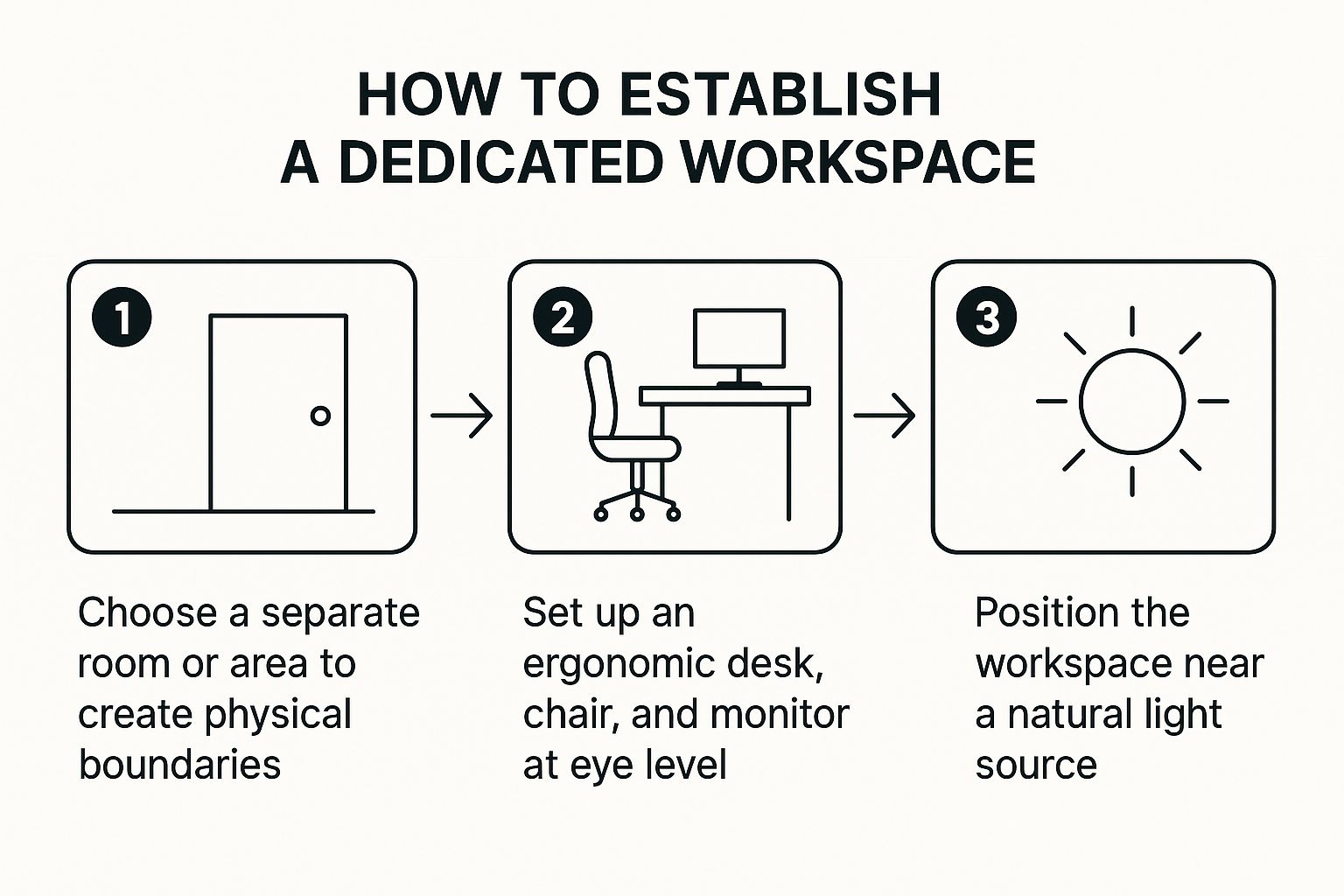8 Essential Remote Work Productivity Tips for 2025
The shift to remote work offers unparalleled flexibility, but it also presents unique productivity challenges. Distractions are abundant, the lines between professional and personal life blur, and the inherent structure of a traditional office is gone. To thrive, not just survive, in this environment, you need more than a good internet connection; you need a strategic operational framework. This guide provides a definitive list of remote work productivity tips, moving beyond generic advice to offer actionable, field-tested strategies for professionals, from software engineers to founders and writers.
We'll explore precisely how to structure your day, optimize your physical and digital environment, and leverage powerful techniques to reclaim your focus. The goal is to help you produce high-quality work consistently and achieve a sustainable work-life balance without the risk of burnout. Whether you're a seasoned remote professional or new to the work-from-home world, these tips will serve as your blueprint for mastering the modern workday. This article cuts straight to the methods that deliver results, detailing everything from establishing a dedicated workspace and implementing structured communication to mastering deep work sessions and creating a definitive end-of-day shutdown ritual.
1. Establish a Dedicated Workspace
One of the most impactful remote work productivity tips is creating a clear distinction between your personal and professional environments. A dedicated workspace serves as a powerful psychological cue, signaling to your brain that it's time to focus. When you enter this space, you're "at work," and when you leave, you can more easily disconnect and recharge. This physical boundary is crucial for preventing burnout and maintaining a healthy work-life balance.
Why a Dedicated Space is Non-Negotiable
Working from the couch or bed blurs the lines between relaxation and work, often leading to decreased focus and a feeling of being "always on." By designating a specific area exclusively for professional tasks, you create a controlled environment optimized for concentration. This approach is so effective that leading remote-first companies actively support it. For example, remote-first companies like Automattic and Shopify provide home-office stipends or allowances to support dedicated workspaces. These companies recognize that a well-designed workspace is a direct investment in employee productivity and well-being.
Actionable Steps to Create Your Workspace
Creating an effective workspace doesn't have to be complicated. The following infographic outlines a simple, three-step process to get you started.

This process emphasizes that the foundation of a productive workspace rests on location, ergonomics, and lighting. To take it a step further:
- Invest in an ergonomic chair. You will spend thousands of hours in it, making it one of the most important investments for your long-term health.
- Position your monitor at eye level to prevent neck and shoulder strain.
- Use noise-canceling headphones if your workspace is in a shared or high-traffic area of your home.
- Keep it clean. A tidy space reduces mental clutter. Spend five minutes at the end of each day organizing your desk for the next morning.
2. Time Blocking and Calendar Management
To supercharge your remote work productivity, move beyond a simple to-do list and embrace time blocking. This is a time management method where you divide your day into distinct blocks of time, each dedicated to a specific task or type of work. Instead of reacting to interruptions, you proactively assign every minute of your workday a job, transforming your calendar from a record of appointments into a detailed plan for execution. This approach, advocated by productivity experts like Cal Newport, is one of the most effective remote work productivity tips for minimizing context-switching and ensuring high-priority tasks get the focused attention they deserve.

Why Proactive Scheduling is Non-Negotiable
A reactive workday is an unproductive one. Without a plan, your attention is pulled between emails, messages, and unplanned requests, leaving little room for deep, focused work. Time blocking creates a powerful defense against these distractions. Tech teams and industry leaders utilize this method to maximize output. Google employees often block calendar focus time, and Microsoft's Outlook includes a "Focus Time" feature that can automatically reserve slots for uninterrupted work. This proactive scheduling ensures that your most important work gets done, rather than what is merely most urgent.
Actionable Steps to Master Your Calendar
Implementing time blocking is a straightforward process that can revolutionize your daily output. By intentionally scheduling every part of your day, you gain control and clarity.
- Prioritize Deep Work Early. Block out a 90-120 minute session for your most cognitively demanding task in the morning when your energy and focus are at their peak.
- Color-Code Your Blocks. Use different colors for different categories of work, such as deep work (blue), meetings (red), administrative tasks (green), and breaks (yellow). This provides an instant visual overview of your day.
- Batch Your Administrative Tasks. Instead of checking email and messages constantly, schedule two or three specific blocks (e.g., 9:00 AM, 1:00 PM, 4:00 PM) to handle all administrative work at once.
- Schedule Breaks and Buffers. Your brain needs rest. Schedule 10-15 minute breaks between blocks to stretch, hydrate, or step away from your screen. This prevents burnout and maintains high performance throughout the day.
- Review and Adapt Weekly. Spend 15 minutes at the end of each week reviewing your calendar. Identify what worked and what didn't, then adjust your blocks for the upcoming week accordingly.
3. The Pomodoro Technique for Focused Work Sessions
The Pomodoro Technique is a powerful time management method that breaks your workday into focused, 25-minute intervals separated by short breaks. Developed by Francesco Cirillo, this system uses a timer to create a sense of urgency and rhythm, leveraging the brain's natural ability to maintain high focus in short bursts. For remote workers facing endless distractions, it provides a structured framework to combat procrastination and mental fatigue.

Why This Technique Excels in Remote Settings
Without the structure of a traditional office, it's easy for the day to become a blur of unfocused multi-tasking. The Pomodoro Technique imposes a clear, simple structure that makes large tasks feel less daunting and prevents burnout. Its effectiveness is validated by its adoption across various industries. For instance, many software teams adapt Pomodoro-style sessions for focused coding sprints, and writers often credit the method for helping them draft high-quality content without distraction. This technique transforms your perception of time, turning it from an abstract concept into a series of concrete, manageable work blocks.
Actionable Steps to Implement the Pomodoro Technique
Getting started is simple, but consistency is key. The core idea is to fully commit to a single task during each interval, treating the timer as an unbreakable contract with yourself.
- Plan your Pomodoros. Before you start, list the tasks you need to accomplish and assign them to specific Pomodoro slots. This is one of the most effective remote work productivity tips for creating a clear daily roadmap.
- Use a dedicated timer. Avoid using your phone, which is a source of distraction. A physical kitchen timer or a simple, single-purpose app works best.
- Take real breaks. When the timer rings, step away from your desk. Stretch, grab a glass of water, or walk around for five minutes. This physical separation is crucial for mental reset.
- Start small and adjust. Begin with just 2-3 Pomodoros per day and build from there. If 25 minutes feels too short, experiment with longer 50-minute intervals and 10-minute breaks to find what suits your focus capacity.
- Track your progress. Note how many Pomodoros you complete each day. This data will reveal your most productive hours and help you better plan your schedule over time.
4. Structured Communication Protocols
One of the most powerful remote work productivity tips is to move beyond chaotic, always-on communication. Structured communication protocols create a clear framework for how and when your team interacts, reducing digital noise and preventing burnout. This means defining which tools to use for specific purposes, setting clear response time expectations, and defaulting to asynchronous methods whenever possible. This intentional approach minimizes interruptions and allows for deep, focused work.
Why Structured Communication is Non-Negotiable
In a remote setting, the lack of clear guidelines leads to constant Slack notifications, endless email chains, and a pervasive feeling of being tethered to your devices. This communication overload kills productivity and creates unnecessary stress. By establishing protocols, you replace ambiguity with clarity. This is a core principle for highly successful remote companies. For example, GitLab's extensive public handbook outlines their communication hierarchy in detail, while Doist, the company behind Twist, built its entire collaboration tool around the philosophy of asynchronous-first communication. These leaders prove that structured, intentional communication is the bedrock of a high-functioning remote team.
Actionable Steps to Structure Your Communication
Implementing these protocols doesn't require a complete overhaul. It's about setting clear, simple expectations that everyone can follow.
- Create a Communication Charter. Document which tools to use for what. For instance: Slack for urgent, quick questions; Email for formal external communication; and a project management tool like Asana for task-specific updates.
- Default to Asynchronous. Frame questions and updates with enough context that an immediate reply isn't needed. This respects different time zones and deep work blocks.
- Establish Response Time Expectations. A common guideline is to acknowledge non-urgent messages within 24 hours. This removes the pressure for instant replies.
- Use Statuses Effectively. Encourage honest use of "Busy," "In a Meeting," or "Do Not Disturb" statuses to signal availability for synchronous chat.
- Implement a '10-Minute Rule'. Borrowed from Zapier, if a topic takes more than 10 minutes to explain via text, it’s time to schedule a quick call. This prevents lengthy, confusing text-based debates.
- Keep Discussions Organized. Use threaded conversations in Slack to keep channels clean and make information easy to find later.
5. Regular Breaks and Movement Integration
One of the most counterintuitive yet powerful remote work productivity tips is to intentionally step away from your work. Integrating scheduled breaks and physical movement throughout the day is essential for maintaining focus, creativity, and well-being. Unlike a traditional office with built-in movement like walking to meetings or grabbing coffee, remote work can lead to prolonged, unhealthy periods of sitting.

Why Breaks Are a Productivity Multiplier
Staying chained to your desk for hours on end actively harms your output. Research has popularized the idea that excessive sedentary behavior hurts health and focus—"sitting is the new smoking" is a common shorthand for that risk. By strategically incorporating breaks, you combat mental fatigue and physical strain, leading to higher quality work. For example, Some pilots, like Microsoft Japan's 4-day work week with mandated breaks, have reported large productivity gains (their internal report cited around 40%). This proves that rest isn't the opposite of work; it's a vital part of it.
Actionable Steps to Integrate Movement
Building movement into your remote routine requires deliberate planning. The key is to make breaks non-negotiable and easy to implement.
- Schedule Walking Meetings. For one-on-one calls that don't require screen sharing, take the conversation on the go. This is a simple way to get steps in while staying productive.
- Use the 20-20-20 Rule. Every 20 minutes, look at something 20 feet away for 20 seconds. This simple practice helps reduce digital eye strain significantly.
- Set Automatic Reminders. Use your phone, calendar, or a dedicated app to prompt you to stand up, stretch, or walk around for a few minutes every hour.
- Never Eat at Your Desk. Physically leaving your workspace for lunch creates a powerful mental reset, allowing you to return with renewed focus and energy.
- Practice Desk Stretches. Simple neck rolls, shoulder shrugs, and torso twists can alleviate tension and prevent stiffness. A quick 5-minute routine can make a huge difference.
6. Morning Routines and Start-of-Day Rituals
Establishing a consistent morning routine is a critical productivity strategy for remote workers who lack the natural transition of a commute. A well-designed routine creates a psychological separation between personal and professional time, priming your mind for focused work and setting a positive tone for the entire day. This ritual signals to your brain that the workday is officially beginning, preventing the sluggish start that can happen when home and office are the same place.
Why a Start-of-Day Ritual is Non-Negotiable
Without the structure of a commute, it's easy to roll out of bed and straight into work, blurring boundaries and leading to mental fatigue. An intentional morning ritual acts as a "mental commute," creating a buffer that improves focus and reduces stress. This practice is a cornerstone for many high-achievers. For example, author Hal Elrod popularized the "Miracle Morning" concept, while productivity expert Tim Ferriss advocates for a mix of meditation and light exercise. Similarly, former President Barack Obama made exercise a non-negotiable part of his morning, demonstrating that even the busiest schedules can accommodate a preparatory ritual. These leaders understand that how you start your day dictates its entire trajectory.
Actionable Steps to Build Your Morning Routine
Crafting an effective routine doesn't require a complete lifestyle overhaul. Start small and build habits that energize you for the day ahead.
- Simulate a commute. Take a 10-minute walk outside before you sit down at your desk. This physical separation is a powerful cue to your brain.
- Get dressed for work. Changing out of pajamas and into "work clothes" reinforces the mental shift into a professional mindset.
- Plan your top 3 priorities. Before checking emails or Slack, identify the three most important tasks for the day. This ensures you start with intention rather than reacting to others' demands.
- Avoid immediate screen time. Give yourself at least 30 minutes after waking before you look at your phone or computer. Use this time for activities like stretching, journaling, or enjoying a coffee away from your desk.
7. Asynchronous Deep Work Sessions
In a remote environment saturated with constant notifications, one of the most powerful remote work productivity tips is mastering asynchronous deep work. This practice involves scheduling extended, uninterrupted blocks of time (typically 2-4 hours) to focus on a single, cognitively demanding task. During these sessions, the expectation of real-time communication is intentionally suspended, allowing for profound concentration and high-value output.
Why Deep Work is a Remote Superpower
Deep work, a concept championed by author Cal Newport, is the ability to focus without distraction on a complex task. In a world of shallow, reactive work like answering emails and Slack messages, the capacity for deep work has become both rare and immensely valuable. For remote workers, it's a superpower that generates disproportionate results. Companies like Basecamp have institutionalized this with "Library Rules," where interruptions are forbidden during certain hours to protect employee focus. Similarly, Bill Gates is famous for his "Think Weeks," where he isolates himself to read and think deeply, demonstrating the immense value of this practice at the highest level.
Actionable Steps to Implement Deep Work
Integrating deep work requires discipline and clear boundaries with your team. It's a skill you develop over time, not a switch you flip overnight.
To get started, follow these practical steps:
- Schedule it. Block out deep work sessions in your calendar just as you would a meeting. Start with 90-minute blocks and gradually increase the duration.
- Communicate your schedule. Let your team know when you will be unavailable for immediate responses. A simple status update like "Deep work until 11 AM, will respond after" is sufficient.
- Eliminate digital distractions. Use tools like Freedom or Cold Turkey to block distracting websites and apps. More importantly, put your phone in another room.
- Create a pre-work ritual. Signal to your brain that it's time to focus. This could be making a specific type of tea, listening to a particular playlist, or tidying your desk.
- Keep a "distraction pad." When an unrelated thought pops into your head, write it down on a notepad to address later. This acknowledges the thought without derailing your focus.
- Use a shutdown ritual. At the end of your session, create a clear transition out of work mode. Review your progress, plan the next steps, and verbally say "shutdown complete" to signal the end of your workday.
8. End-of-Day Shutdown Ritual
One of the most challenging aspects of remote work is knowing when to stop. Without the physical act of leaving an office, work can easily bleed into personal time, leading to burnout. An end-of-day shutdown ritual is a structured routine that creates a clear, definitive end to your workday, helping you mentally transition from professional to personal mode. This practice is a cornerstone of sustainable remote work productivity tips.
Why a Shutdown Ritual is Non-Negotiable
Failing to properly disconnect leaves your brain in a state of "attention residue," where thoughts about unfinished tasks linger and cause anxiety. This mental clutter prevents you from fully recharging, which hurts your focus and energy for the next day. Productivity expert Cal Newport, author of Deep Work, champions this ritual, stating that it allows your mind to completely disengage. Similarly, Arianna Huffington advocates for a ritual that includes physically putting her laptop in another room. These leaders understand that a proper shutdown is not about ending work; it's about preserving your capacity to perform at your best tomorrow.
Actionable Steps to Create Your Ritual
Your shutdown ritual should be consistent and deliberate. It doesn't need to be complex, but it must be followed every day to signal to your brain that the workday is officially over.
- Set a shutdown alarm. Schedule an alert 20-30 minutes before you plan to finish. This is your cue to start winding down, not to cram in one last task.
- Review and plan. Spend a few minutes reviewing what you accomplished. Then, identify your top three Most Important Tasks (MITs) for the next day. This ensures you start tomorrow with clarity and purpose.
- Clear your digital space. Close all work-related tabs, applications, and software. This includes email, Slack, and project management tools. A clean digital slate prevents late-night temptations to "just check one thing."
- Tidy your physical workspace. Spend five minutes clearing your desk. A tidy space reduces mental clutter and makes it more inviting to start work the next morning.
- Perform a concluding action. Use a consistent physical or verbal cue to mark the end. This could be saying "Shutdown complete" out loud, turning off your monitor, or taking a short walk around the block to mimic a commute. This final step solidifies the boundary between work and life.
Remote Work Productivity Tips Comparison
| Strategy | Implementation Complexity 🔄 | Resource Requirements ⚡ | Expected Outcomes 📊 | Ideal Use Cases 💡 | Key Advantages ⭐ |
|---|---|---|---|---|---|
| Establish a Dedicated Workspace | Moderate - requires space and setup | Medium to High - furniture, tech, lighting | High - improves focus, productivity +15-20% | Remote workers needing physical work boundary | Enhances focus, ergonomics & professional image |
| Time Blocking & Calendar Mgmt | Moderate - requires discipline | Low - mainly calendar tools/apps | Very High - up to 40% increase deep work | Knowledge workers managing multiple tasks | Reduces decision fatigue, prevents overcommitment |
| Pomodoro Technique | Low - easy to start | Low - timer or app | High - improved focus and time awareness | Focused individual work like writing, coding | Boosts urgency, prevents burnout, measurable focus |
| Structured Communication Protocols | High - needs planning and enforcement | Medium - defining tools & guidelines | Very High - improves team dynamics | Distributed teams, especially cross-timezones | Reduces meeting overload, improves clarity |
| Regular Breaks & Movement | Low - habit formation needed | Low - reminders, ergonomic aids | High - boosts health and sustained productivity | Remote workers at risk of sedentary behavior | Reduces health risks, improves mood & focus |
| Morning Routines & Rituals | Moderate - consistency required | Low - time and preparation | High - better focus, energy, work-life balance | Individuals needing structured start to day | Sets positive tone, reduces decision fatigue |
| Asynchronous Deep Work Sessions | High - discipline and planning | Low to Medium - scheduling tools | Very High - 50-100% output increase on complex tasks | Knowledge workers needing deep focus | Produces high-quality work, reduces distractions |
| End-of-Day Shutdown Ritual | Low to Moderate - habit building | Low - time for routine | Very High - enhances work-life balance | Remote workers struggling with overwork | Clear work-life boundary, reduces anxiety |
From Tips to Transformation: Building Your Productive Routine
The journey to mastering remote work is not a sprint; it's a marathon of continuous improvement and intentional habit formation. The strategies we've explored, from dedicating a specific workspace to implementing a definitive end-of-day shutdown ritual, are not isolated tricks. They are interconnected components of a holistic system designed to give you control over your day, your focus, and your well-being. True productivity isn't just about getting more done; it's about doing the right things with less stress and greater satisfaction.
Weaving the Threads Together
Think of each of these eight remote work productivity tips as a thread. Individually, each one can make a noticeable difference.
- Time blocking brings structure to an otherwise open-ended day.
- A morning routine sets a proactive tone, preventing you from starting your day in a reactive state.
- Structured communication protocols eliminate the constant drain of notifications and unnecessary meetings.
- An end-of-day shutdown creates a clear boundary, protecting your personal time and preventing burnout.
When you begin to weave these threads together, you create a strong, resilient fabric: a personalized productivity system. This system becomes the foundation upon which you can build a sustainable and fulfilling remote career, one that supports deep work and preserves a healthy work-life balance.
Your Actionable Next Steps
The sheer number of tips can feel overwhelming, but the key is to start small and build momentum. Don't try to implement everything at once. Instead, identify your biggest pain point right now and choose one or two strategies to address it directly.
- Identify Your Biggest Hurdle: Is it constant distractions? A lack of structure? The inability to switch off after work? Pinpoint the most significant challenge you face daily.
- Choose Your Starting Point:
- If you struggle with focus, start with the Pomodoro Technique for your next task.
- If your days feel chaotic and unstructured, implement time blocking for tomorrow.
- If you feel like you're always "on," commit to a simple shutdown ritual tonight.
- Track and Adjust: Consistently apply your chosen technique for one week. At the end of the week, reflect on what worked and what didn't. Make small adjustments and either continue refining that habit or add another one into the mix.
The goal is not perfection but progress. By layering these habits over time, you transform abstract advice into a concrete, effective routine that is uniquely yours. This is how you move from simply reading about remote work productivity tips to truly living them, unlocking not just higher output but a more enjoyable and sustainable way of working.
Ready to supercharge your writing and documentation speed? Explore how Paraspeech can help you draft emails, code comments, and reports up to three times faster with secure, offline dictation on your Mac. Visit Paraspeech to see how you can reclaim hours in your week.



